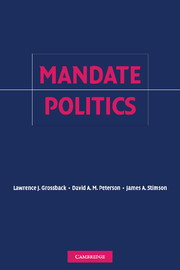Book contents
- Frontmatter
- Contents
- List of Figures
- List of Tables
- Preface
- Acknowledgments
- 1 A Single Time in a Single Place
- 2 The Evolution of Mandates
- 3 Members of Congress Respond
- 4 The Pattern of Congressional Response
- 5 Consequences
- 6 The Irresistible Meets the Unmovable
- 7 Conclusion: A Mandate View of Normal American Politics
- Bibliography
- Index
2 - The Evolution of Mandates
Published online by Cambridge University Press: 14 August 2009
- Frontmatter
- Contents
- List of Figures
- List of Tables
- Preface
- Acknowledgments
- 1 A Single Time in a Single Place
- 2 The Evolution of Mandates
- 3 Members of Congress Respond
- 4 The Pattern of Congressional Response
- 5 Consequences
- 6 The Irresistible Meets the Unmovable
- 7 Conclusion: A Mandate View of Normal American Politics
- Bibliography
- Index
Summary
Three Congresses in the modern era have started work in the presence of widespread belief – inside and outside the institution – that their actions would be closely watched by willful voters. The 89th Congress in 1965, the 97th in 1981, and the 104th in 1995 had in common a charged Washington environment, a sense that they must act. This sense, a widely shared belief that they acted under a voter mandate, came from some place and some time before early January, when they began their business. It came, or at least seemed to, from the previous November, from the first Tuesday after the first Monday of that previous November.
But elections do not interpret themselves, do not speak of mandates, do not speak of much of anything except who got how many votes. From somewhere in the campaign, from Election Day, and from the public dialogue after the election, a message arose, was debated, and became agreed on by most people in the Washington community – and by the community of politics outside the beltway. The task of this chapter is find when, how, and from where it came. Our task is to try to understand public dialogues about mandates.
- Type
- Chapter
- Information
- Mandate Politics , pp. 27 - 62Publisher: Cambridge University PressPrint publication year: 2006



